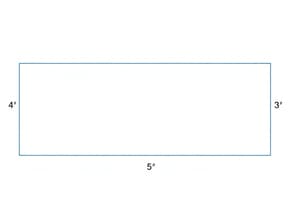Podcast
Questions and Answers
What is the primary difference between perimeter and area?
What is the primary difference between perimeter and area?
- Perimeter is only applicable to squares and rectangles, while area applies to all shapes.
- Perimeter represents the inside of a shape, while area represents the outside.
- Perimeter is always calculated in square units, while area is measured in linear units.
- Perimeter is the measure of the boundary of a shape, while area is the measure of the surface it covers. (correct)
How does one find the perimeter of a triangle?
How does one find the perimeter of a triangle?
- Adding the lengths of all three sides together. (correct)
- Multiplying the base by the height and dividing by 2.
- Adding up all the angles of the triangle.
- Multiplying one side length by 3.
Which shape's area is found by squaring its side length?
Which shape's area is found by squaring its side length?
- Triangle
- Square (correct)
- Circle
- Rectangle
What does the area of a rectangle represent?
What does the area of a rectangle represent?
When finding the perimeter of a rectangle, what operation is required?
When finding the perimeter of a rectangle, what operation is required?
What is the primary focus of studying geometry, according to the text?
What is the primary focus of studying geometry, according to the text?
Why is the knowledge of perimeter and area important in landscaping?
Why is the knowledge of perimeter and area important in landscaping?
Which ancient civilization provided some of the earliest examples of geometry?
Which ancient civilization provided some of the earliest examples of geometry?
How do artists and architects use concepts of perimeter and area?
How do artists and architects use concepts of perimeter and area?
In what modern fields are perimeter and area concepts still relevant?
In what modern fields are perimeter and area concepts still relevant?
Flashcards are hidden until you start studying
Study Notes
Mastering Menstruation in Grade 7: All About Perimeter and Area
If you're in Grade 7, you'll soon be discovering the fascinating world of geometry. Your curriculum will delve into the fundamentals of perimeter and area, two essential concepts that will help you understand shapes, calculate their sizes, and solve real-world problems with ease.
Perimeter
The perimeter of a shape is the distance around its boundary, often measured in units like centimeters or inches. In simpler terms, the perimeter is the length of the edge of the shape. Let's consider a few common examples:
- A square has 4 sides, and each side is equal in length. To find the perimeter of a square, simply multiply the side length by 4.
- A rectangle has two pairs of opposite sides that are equal in length. To find its perimeter, add the lengths of the four sides together.
- A triangle has three sides, and their lengths do not have to be the same. To find its perimeter, add the lengths of all three sides together.
Area
In contrast to perimeter, the area of a shape is a measure of the amount of surface it covers. Area is typically represented in square units like square centimeters or square inches. Some important formulas and concepts include:
- The area of a rectangle is found by multiplying its width by its height.
- The area of a square is found by squaring its side length.
- The area of a triangle is calculated using the formula (\frac{1}{2} \times \text{base} \times \text{height}).
As you progress in your study of geometry, you will learn to calculate the area and perimeter of more complex shapes like circles, trapezoids, and polygons.
Applications
These concepts, perimeter and area, have real-world applications.
- Landscaping: You can use perimeter and area measurements to calculate the amount of material needed to fence a garden or to estimate the cost of landscaping services.
- Construction: Contractors use perimeter and area to calculate the amount of materials like wallboard, carpet, or paint required for a job.
- Design: Artists and architects use these concepts to determine the size of their work and to plan their designs.
A Bit of History
The study of perimeter and area dates back to ancient times. The earliest known examples of geometry come from Babylonian clay tablets dating back to 2000 BCE. The ancient Greeks, including mathematicians like Pythagoras and Euclid, developed the foundations of geometry that we still study today. These concepts have remained relevant and important throughout history, with applications in fields ranging from engineering to architecture to data analysis.
So, as you dive into the world of Grade 7 geometry, keep these core concepts of perimeter and area in mind. They will serve as the building blocks for understanding more complex shapes and problems, and they will provide a solid foundation in mathematics for years to come.
Studying That Suits You
Use AI to generate personalized quizzes and flashcards to suit your learning preferences.




